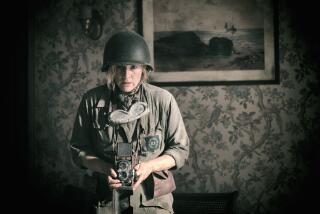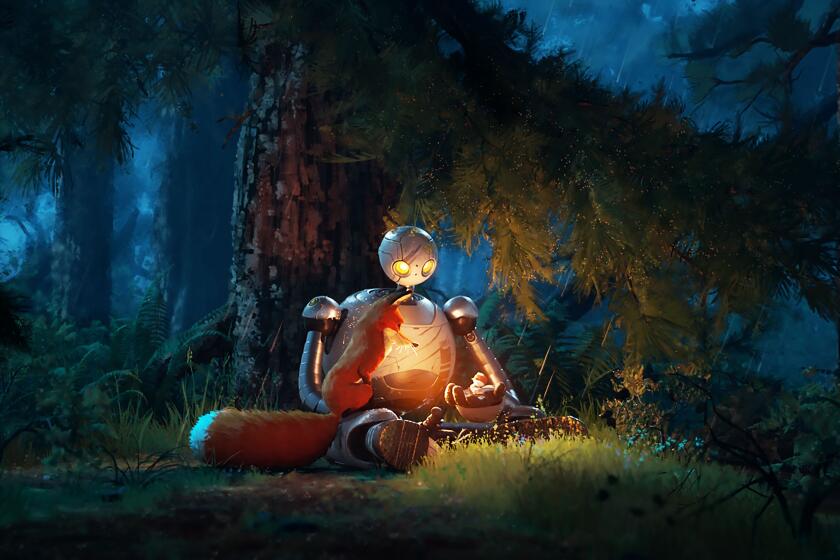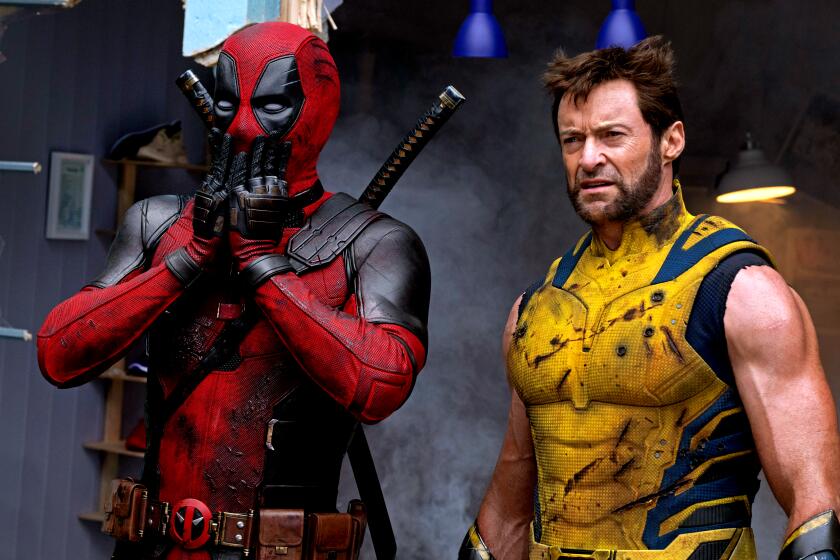Greenaway’s Way
British filmmaker Peter Greenaway has a list of pet peeves, and at the top of that list is the fact that since its birth a century ago, cinema has leaned on literature like a helpless infant.
“We shower ‘The English Patient’ with Academy Awards, but why was it even made?” Greenaway asks with exasperation. “It was a perfectly decent novel. Are we so lazy and stupid that we can’t imagine any application of cinema other than illustrating books? If you want to tell stories, be a writer not a filmmaker!
“D.W. Griffith did us a great disservice in suggesting cinema should be an adjunct to the 19th century novel, and in its present form, film is too boring to attract intelligent artists,” says the 55-year-old director. “Most people with the potential of making great films have gone elsewhere, and as far as I’m concerned one [video artist] Bill Viola is worth 10 Scorseses.”
A longtime darling of the art-house circuit, Greenaway, whose ninth feature, “The Pillow Book,” opens Friday, is no shrinking violet when it comes to expressing his opinion, and he concedes to having a streak of arrogance. “Arrogance is a prerequisite for being an artist,” he flatly declares. “Without it, one would be destroyed by the slings and arrows of doing something publicly, so if you want to boldly go where none have gone before, you must trail arrogance along with you.”
Beginning in 1980 with his debut feature, “The Falls,” Greenaway has fearlessly blazed his own trail with a series of films that are at once perverse, baffling and visually spectacular.
His biggest commercial success thus far has been “The Cook, the Thief, His Wife and Her Lover,” a savage drawing-room comedy released in 1989 that was a veritable catalog of unpleasant things. Like all Greenaway films, “The Cook . . . “ presented several challenges: to bring a body of knowledge to the act of watching a film, to examine long-held beliefs and to dispense with linear narrative and experience a story in a new fashion.
“There are ways other than linear narrative to organize material,” says Greenaway of a belief central to his creative methodology. “The grid, numerical systems, color coding--all are capable of putting the chaos of existence into some kind of comprehensible pattern. As a director, I’m free to create a drama with three actors or 300, and I can set the action on the moon or in my home. Such freedom can be overwhelming, so I invent other systems to discipline the hundreds of events that make up a film.”
If such talk about systems theory sounds a bit cold, it is; for all their intelligence, Greenaway’s films have been a bit chilly thus far. “The Pillow Book,” however, marks a breakthrough in this regard. Whereas his previous films have been grounded in a jaundiced view of human nature that makes for decidedly unlikable characters, “The Pillow Book” suggests that the director feels something akin to tenderness for the people who move its gears.
Based on the writings of Sei Shonagon, a lady-in-waiting in the Japanese Heian Dynasty Imperial Court of the 10th century, and starring Vivian Wu and Ewan McGregor, “The Pillow Book” is explained by Greenaway as “a story about narration. The actual narrative, however, is highly reduced, and it fragments time in a way I hope allows it to transcend what I call ‘The Casablanca Syndrome’; character-driven narratives with a beginning, middle and end.”
“The Pillow Book” makes use of elaborate split screens and special effects to underscore the Asian concepts of beauty central to the story. Ultimately, however, Greenaway relies on Chinese actress Wu to carry the film; she appears in nearly every scene, is nude in many of them, and goes through a dramatic transformation over the course of the movie.
“Peter shoots long takes and there were scenes where I felt I was dragging on and hadn’t a clue what he was after,” Wu recalls. “It wasn’t until I saw the film that I understood why he let certain scenes play out that way. Peter was assembling a puzzle in his mind and that’s how he created specific pieces he needed.”
This particular puzzle concerns itself with erotic love, among other things. “I always put the body at the center of the frame and many of my images are extremely romantic,” says Greenaway, who lives in London with his wife and two daughters, and estimates he’s had “two and a half great love affairs in my life. Sensuality, the body, textures, colors--these things are present in all my films, but they’re held in check by rationality.
“My primary concern is not to engage you emotionally,” he sternly points out. “Obviously that’s necessary, but I’m interested in things beyond the tedious need to create an emotional rapport between the screen and the audience. The unchecked ability to use our emotions isn’t beneficial to us, and the worst excesses of uncivilized behavior rely on notions of romanticism. So I try to hold romanticism in check by imposing rigid structures.”
Greenaway’s structures are occasionally so incomprehensibly solipsistic that the films he imposes them on never even get picked up for distribution. His 1993 film, “The Baby of Macon,” for instance, has yet to be seen in the U.S., despite the fact that it stars Ralph Fiennes and Julia Ormond.
“ ‘The Baby of Macon’ dealt with the exploitation of children, the humiliation of women, and Roman Catholicism--which is very much like cinema in that both rely on a suspension of disbelief,” says Greenaway, whose films are budgeted at an average of $5 million. “The film also draws analogies between Baroque propaganda of the 17th century and cinematic propaganda--the contemporary need for films riddled with sex, violence and sensation has much in common with Baroque tastes of the late 17th century.”
Of the arcane references that permeate this, and all, his films, Greenaway says, “my hope is that the films work on different levels.
“My film of 1982, ‘The Draughtsman’s Contract,’ for instance, could be interpreted as an Agatha Christie country-house drama,” adds the director, who’s currently in pre-production for an eight-hour film, “The Tulse Luper Suitcase,” which he hopes to present both as a television series and on the Internet. “If you have no knowledge of the symbolism of fruit, or that Protestants of that period treated their servants differently than Catholics did, you could still enjoy the film on that level. If you do know those things, you’ll probably enjoy it more.”
Born in 1942 in Wales, Greenaway recalls “my father was an amateur ornithologist who spent as much time as possible wading around marshes clutching a pair of binoculars, and his interests permeated my imagination. I’ve always been interested in landscape and how ecological problems relate to it, and those concerns are apparent in my films.
“My father didn’t return from [World War II] until I was 5 years old, and I suppose his absence during those years of my childhood was significant. I think many of my early films were attempts to communicate with him, as it were, after his death. ‘A Walk Through H,’ ‘The Falls’ and ‘Water Rackets,’ which is about the dictatorial organization of landscape, all contain ideas about who I thought my father was. And since he died of stomach cancer, I suppose my 1987 film, ‘The Belly of the Architect,’ is a kind of homage to him.”
By the age of 12, Greenaway had decided to become a painter, and he earned a degree in painting and art history at London’s Walthamstow College of Art. In 1965, however, his exposure to the films of Ingmar Bergman, Alain Renais and Luis Bun~uel inspired him to train as a film editor, and the following year he landed a job that was to last 11 years directing and editing films for the government’s Central Office of Information. Greenaway’s been steadily making films ever since, but he’s never allowed that to interfere with his practice as a painter, which has continued without interruption.
Currently at work on two operas--”100 Objects to Represent the World” and “Writing to Vermeer”--slated to premier this year in Europe, Greenaway shrugs his shoulders when asked about his box-office hopes for “The Pillow Book.”
“Audiences love my films or they hate them--and the vehemence with which they hate them knows no bounds,” he laughs. “My audiences break down into three groups: people who realize they’ve made a mistake after five minutes and leave the theater shouting insults; people who give me the benefit of the doubt and wait 40 minutes before leaving; and people who stay through the film, then see it again and again. Those are the people who’ve made it possible for me to make films, and thus far there seem to be enough of them.”
More to Read
Only good movies
Get the Indie Focus newsletter, Mark Olsen's weekly guide to the world of cinema.
You may occasionally receive promotional content from the Los Angeles Times.








